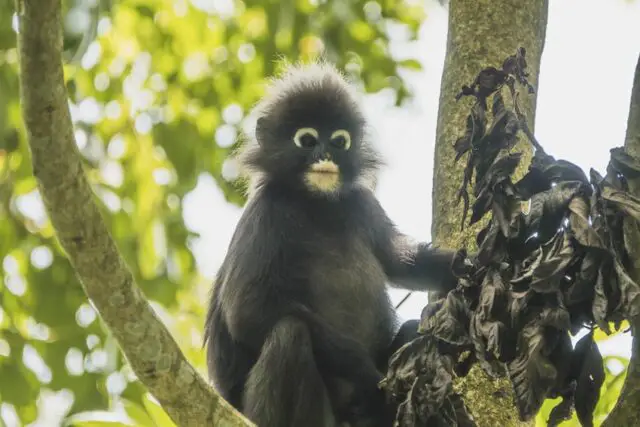
Penang island is well known around the world for its characteristic Penang Food, multi-ethnic heritage, and culture that reflect in a number of amazing Penang festivals, Kek Lok Si Temple, one of Southeast Asia’s largest Buddhist shrines, and many great things to do with kids in Penang.
Few visitors to Penang, however, consider going beyond the obvious things to do for first-timers, such as going on top of Penang Hill, chasing Penang famous street art, to go explore the jungle at Penang Botanical Gardens and Penang National Park, which are the habitat of a good number of Malaysian animals.
Malaysian wildlife includes some very strange and unique tropical animals that you won’t be able to see anywhere else in the world.
Of course, most live in the jungle and they are hard to spot at the best of times — but you should know what you can find in those thick jungles, isn’t it?
This article collects a list of the most common, incredible, and unique Malaysian animals you can find on Penang island. Unfortunately, some of them are endangered species in Malaysia, and thankfully, there are people who work towards the conservation of their number and their habitat. For starters, you should check out The Habitat Penang Hill.
If you love what you’ll see and want more in-depth details and maybe do some actual research, Dr. Nadine Ruppert and her dedicated students at Universiti Sains Malaysia are behind the very important Langur Project Penang and Night Spotting Project — the latter dedicated to Penang’s night creatures, such as the beautiful Sunda colugo. Together with the Malaysian Primatological Society, they welcome volunteers to join their various wildlife conservation projects all over Malaysia.
But for now… just have a look at what Malaysian animals you’ll be able to find on Penang island, and then go for a hike with eyes wide open.
Incredible Malaysian Animals You Can See in Penang
1Long-tailed Macaque
Let’s start with the most common Malaysian animal you can see all over Penang’s parks and less developed areas. Tourists and locals just refer to it as “monkey”, but the correct name for this cheeky and oftentimes nasty primate is long-tailed macaque — also called crab-eating macaque (yes, they DO eat crabs…) more often forages for jungle food, and unfortunately, the food that too many stupid humans keep throwing at them in many of Penang’s beaches and parks.
Long-tailed macaques live in groups, with more females than males, and when they carry babies it can be quite dangerous to approach them. If you find a troop of them on a Penang hiking trail such as Moongate to Station 5 please keep walking and don’t look at them in the eye or show them your teeth (smile) — they are generally innocuous, but it’s best not to interact with them to avoid a bite that needs to be treated immediately to avoid the risk of a potentially deadly Hepatitis B infection. That’s why, again, you should avoid feeding wild animals, which makes them more used to humans and consequently can cause harm to them and us.
2Dusky Langur

Also called dusky leaf monkeys, spectacled langurs, or spectacled leaf monkeys, these Malaysian animals are possibly the cutest of the lot. With that round, soft black face, white circles around their eyes, and a cute white mouth patch, they are just irresistible. Not as cheeky and aggressive as the long-tailed macaques, the dusky leaf monkeys spend most of their time foraging for leaves high in the canopy, and it’s not always easy to spot them as they tend to hide up in the higher trees.
Their cuteness, and the curious fact that their babies have beautiful golden fur, is threatening their populations as people illegally remove them from the wild to keep them as pets. It’s against the law to have primates or any other wildlife in Malaysia as a pet without a proper license that needs to be issued by the Wildlife Department. Failing to get a permit can land you in jail and cost you a hefty sum (max. RM500,000 – yes, you read this correctly!).
Dusky langurs are still quite spread all over Penang island and especially in the jungles on each side of Penang Hill. In Teluk Bahang near Tropical Spice Garden (one of the best places for pre wedding photography in Penang), the Langur Project Penang has established the first urban canopy bridge in Malaysia to help these primates and other arboreal species to cross the busy coastal road that often poses a death sentence for animals who try to reach from the forest to the beach. If you catch sight of a group with a mum holding its orange baby up in the trees, consider yourself double lucky.
3Sunda Colugo

The Sunda Colugo or Sunda Flying Lemur is an impressive member of Malaysia’s wildlife family. It is neither a lemur (primates that can only be found in Madagascar) nor is it truly flying (bats are the only mammals that developed true flight). And admittedly, at first sight, the Sunda Flying lemur is indeed hard to come to grips with: it looks like a mix between a big bat, a macaque, and a cat, but it is a member of its own group of mammals that are very closely related to primates. It usually clings to tree trunks and is exceptionally well camouflaged, with its brownish spotted fur, making it even harder to see. If you look closely, sometimes a cute baby will lurk from the mother’s underside.
The Sunda colugo is strictly arboreal and active at night, feeding on leaves, shoots, fruits, and the other things they can find in the canopy. Unlike its name, the Sunda flying lemur doesn’t exactly fly — it uses a large membrane– called patagium- that spans its entire body, including all paws and tail to glide between trees.
It jumps from higher elevations to lower ground often covering several hundred meters, and then climbs up a tree to glide again. Colugos are the most accomplished of all gliding animals and have some other peculiar features as the team from Night Spotting Project has discovered, such as using ultrasound for communication or seemingly lacking eyelids, which means that they have to constantly lick their eyes to stay moist.
The Sunda colugo is an endangered species in Malaysia and is protected. The main issue — as with all wildlife — is habitat loss, deforestation, increasing development and even hunting. Sometimes colugos are killed for their fur, and at times, also for food. If you see one in Penang, consider yourself very lucky — I have only seen a few in 10 years hiking around the island.
4 Sunda Slow Loris

The Sunda slow loris or greater slow loris is an amazing Southeast Asian primate, and unfortunately, a very vulnerable endangered species in Malaysia that is fully protected. It gets its name from its behavior: it moves pretty slowly, and sometimes not at all, and for this reason is harder to spot in the canopy.
On top of that, the Sunda Slow Loris is an arboreal animal and sleeps for the best part of the day, coming out only at night to forage on sap, floral nectar, and fruits. And it’s also very cute, with a round head, small ears hidden in fur, a wet nose, and big, round eyes. It lives alone and spends most of its life up in the trees.
Even if it does exist in Penang, it’s pretty unlikely you’ll come across a Sunda slow loris here, unless you are really looking for it — and even then, good luck with that. If you ever get close to one, please don’t touch it! Known as the only venomous mammal, it has a secretion that it licks from under its armpit to cover its razor blade sharp teeth before it bites. This venomous bite can cause lethal allergic reactions to humans. Cute to watch, but it’s best if you don’t touch — which should always be the main rule for all wildlife sightings.
5Red Giant Flying Squirrel
The red giant flying squirrel is pretty easy to spot in most of Penang Hill jungles. There are several species of flying squirrels scattered from Southeast Asia all the way to China, and even west in the Himalayas, but the red giant one is one of the — you guessed it — largest.
READ MORE — Best Himalayan Hill Stations you Should Visit
With brown-reddish fur and some paler complexion in its underparts, it glides between trees at night, similar to colugos. Its gliding membrane is smaller and does not span its tail, which it uses to steer and control direction.
If you see it, it will most likely zoom past you very fast or will be busy finding food up some tree branch. Tread silently if you want to catch that amazing photo.
6Monitor Lizard
The common Malaysian urban legend of the old man who found a giant lizard sticking out of its toilet bowl may be hilarious, but it’s also much of reality around these parts — it happened to my father in law just last week.
Penang even harbours two species of monitor lizards, the clouded monitor and the Asian water monitor lizard. Both are hard to distinguish for the untrained eye, but they are both smaller cousins of the extremely aggressive Komodo Dragon, and commonly found in most of South and Southeast Asia. Although some individuals can grow quite large, they are not as dangerous as the Komodo Dragon, but yes, they can bite even though they usually eat smaller reptiles, fish, birds and eggs — not humans. Still, for many, their first monitor lizard sighting can be shocking, for sure: some can measure up to three meters.
The monitor lizard usually dwells where there are sources of water — these days, even in sewage drains… that’s why you should always look carefully inside your toilet bowl before you sit 🙂
7Dolphin
Few people would actually believe this as the reputation of Penang’s sea waters is not that great, but there are dolphins swimming around the islands! There are about 27 species of dolphins, whales and porpoise in Malaysia’s seas, and in Penang, rather dolphins are rare to see — but it happens. If you are lucky, you can spot Irrawaddy dolphins, Indo-Pacific humpback dolphins, finless porpoises, and to a less often, the Indo-Pacific bottlenose dolphins!
At the end of 2019, Jeremy Ng Cheng Soon shot a school of about 100 dolphins off Batu Ferringhi using his drone. If you don’t believe us, you can see his video here:
I saw them a couple of times, too: once off the coast around Penang National Park in Teluk Bahang as I traveled on a motorboat to Teluk Kampi, and the other time in Batu Ferringhi — but I didn’t see them as close. Good luck finding Penang dolphins! Such a rare kind of Malaysian wildlife!
8Common Palm Civet

The common palm civet (or Asian palm civet)looks a bit like a wild cat and dwells in the forest and city parks, from where it can occasionally get out to forage on human supplies. Yes, those noises that you oftentimes hear when you visit friends living nearby Penang Hill and the Botanical Gardens can be palm civets coming out of the forest sifting through garbage and looking for food leftovers.
They are cute to see but are very fast and don’t like humans that much, so it’s unlikely that you’ll have a long encounter. This said, the palm civet is mostly a nocturnal animal that’s most active between dawn and 4 am and doesn’t come out that much on nights when the moon is too bright.
Palm civets smell like sweet pandan leaves which is often leading to perceived ghost encounters for clueless people who cannot pinpoint the source of the pleasant smell.
9Common Treeshrew
Even if it looks like a prehistoric squirrel or fluffy jungle rat, this tiny mammal (between 16 and 21 centimeters) is actually a common treeshrew and a close relative of primates. It has a grayish, reddish-brown or black upper fur, and a white belly, with a bushy tail and sharp nails connected to its paws.
Treeshrews are mostly active during the daytime, when they forage for foods on the ground, looking for fruits, seed and leaves, and also insects and spiders — with the odd lizard thrown in for good measure. These cute mammals are strictly monogamous and pair for life, viciously defending their territory against intruders and marking it with a stenchy smell that reminds of a mix of wet dog and truffles.
10Smooth-coated Otter
If you have ever seen an Asian smooth-coated otter — the smallest species of otter in the world — you’ll know how beautiful this amphibian mammal can be. Silky fur, a cute face like a weasel, and movements that are fast and gracious — I was lucky enough to spot a family of otters running from the river onto the banks behind Suffolk House, one of Penang’s best western restaurants and I’ll treasure this memory for a lifetime.
It lives in mangroves, swamps, and coastal areas, gathering in small groups dominated by an alpha male. Otters, however, are an increasingly endangered species in Malaysia and Singapore, as this article explains.
If you are lucky enough to see one, keep your distance, observe, and shut your mouth. You don’t want to go tell around where you have seen them to avoid the risk of poachers going to disturb them — at the best — in their natural habitat.
11Wild Boar
The jungles of Penang are filled with wild boar or, more precisely, Eurasian wild pigs. They love to stay deep in the forest, coming out close to humans only when they know there is food to be had.
Eurasian wild pigs are not necessarily aggressive, but mothers can be when you encounter them with their piglets. Be careful, as wild boar assaults have left people dead. Stay on your path, steer clear of the group, and move away slowly.
Wild pigs are also almost blind so advertise your presence if you accidentally run into a sounder during your hike. Make loud noise and wave your hands, even jump, so that they have the opportunity to move away before either of you comes too close.
12White Bellied Sea Eagle
Penang island hosts a staggering variety of birds, more than 150 species to be precise, and this post is not the place to go deep into that world. However, we’d like to mention at least two beautiful birds that complete this collection of Malaysian animals in Penang.
This diurnal bird of prey, also called white-breasted sea eagle, lives near coastal areas and is distributed from India to Malaysia and Southeast Asia and all the way down to Australia where, to some indigenous peoples, the white-bellied sea eagle is revered as a divinity.
In Penang, you can see the white-bellied sea eagle pretty much everywhere where there is forest and water: they also fly over Penang Hill and many of the other hiking trails in Penang. It may be a common bird, but it’s a pretty impressive sight regardless.
13Bhraminy Kite
Also known as red-backed sea eagle, this beautiful bird inhabits Penang Hill and most other green areas of the island and loves to flutter in the high winds. Take a walk along the hiking trail to Penang Hill’s Mid Station or Moongate to Station 5 and you’ll see plenty of them flying overhead.
Because of the destruction of their native habitat, the Bhraminy kite is declining in numbers and is another endangered animal in Malaysia. They thrive much better in the Matang Mangrove Reserve Area near Taiping in Perak, where they have a much less disturbed environment.
















